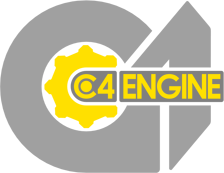
A game engine is a software-development environment designed for people to build video games. Developers use game engines to construct games for consoles, mobile devices, and personal computers. The core functionality typically provided by a game engine includes a rendering engine ("renderer") for 2D or 3D graphics, a physics engine or collision detection, sound, scripting, animation, artificial intelligence, networking, streaming, memory management, threading, localization support, scene graph, and may include video support for cinematics. Implementers often economize on the process of game development by reusing/adapting, in large part, the same game engine to produce different games or to aid in porting games to multiple platforms.
Adobe Shockwave is a multimedia platform for building interactive multimedia applications and video games. Developers originate content using Adobe Director and publish it on the Internet. Such content can be viewed in a web browser on any computer with the Shockwave Player plug-in installed. Macromind originated the technology; Macromedia developed it further, releasing Shockwave Player in 1995. Adobe Systems acquired Shockwave in 2005. Shockwave supports raster graphics, basic vector graphics, 3D graphics, audio, and an embedded scripting language called Lingo.
Torque Game Engine, or TGE, is an open-source cross-platform 3D computer game engine, developed by GarageGames and actively maintained under the current versions Torque 3D as well as Torque 2D. It was originally developed by Dynamix for the 2001 first-person shooter Tribes 2. On September 2012, GarageGames released Torque 3D as open-source software under the MIT License.

Java OpenGL (JOGL) is a wrapper library that allows OpenGL to be used in the Java programming language. It was originally developed by Kenneth Bradley Russell and Christopher John Kline, and was further developed by the Sun Microsystems Game Technology Group. Since 2010, it has been an independent open-source project under a BSD license. It is the reference implementation for Java Bindings for OpenGL (JSR-231).
COLLADA is an interchange file format for interactive 3D applications. It is managed by the nonprofit technology consortium, the Khronos Group, and has been adopted by ISO as a publicly available specification, ISO/PAS 17506.

PhysX is an open-source realtime physics engine middleware SDK developed by Nvidia as a part of Nvidia GameWorks software suite.

The Blender Game Engine is a component of Blender, a free and open-source 3D production suite, used for making real-time interactive content. The game engine was written from scratch in C++ as a mostly independent component, and includes support for features such as Python scripting and OpenAL 3D sound.
Unigine is a proprietary cross-platform game engine, developed by Russian software company Unigine Corp. Apart from its use as a game engine, it is used for virtual reality systems, serious games and visualization. The strongest feature of Unigine is its advanced renderer which currently supports OpenGL 4.0 and DirectX 11. An updated Unigine SDK is released monthly.

The C4 Engine was a proprietary computer game engine developed by Terathon Software that was used to create 3D games and other types of interactive virtual simulations for PlayStation 4, PlayStation 3, Windows, Mac OS X, Linux, and iOS.

Unity is a cross-platform real-time engine developed by Unity Technologies, first announced and released in June 2005 at Apple Inc.'s Worldwide Developers Conference as an OS X-exclusive game engine. As of 2018, the engine has been extended to support 27 platforms. The engine can be used to create both three-dimensional and two-dimensional games as well as simulations for its many platforms. Several major versions of Unity have been released since its launch, with the latest stable version being Unity 2018.3.9.

Bullet is a physics engine which simulates collision detection, soft and rigid body dynamics. It has been used in video games as well as for visual effects in movies. Erwin Coumans, its main author, won a Scientific and Technical Academy Award for his work on Bullet. He worked for Sony Computer Entertainment US R&D from 2003 until 2010, for AMD until 2014, and he now works for Google.

The Physics Abstraction Layer (PAL) is an open-source cross-platform physical simulation API abstraction system. It is similar to a physics engine wrapper, however it is far more flexible providing extended abilities. PAL is free software, released under the BSD license.

3DMLW is an open-source project, and a XML-based Markup Language for representing interactive 3D and 2D content on the World Wide Web.
ShiVa3D is a 3D game engine with a graphical editor designed to create applications and video games for desktop PCs, the web, game consoles and mobile devices. Games made with ShiVa can be exported to over 20 target platforms, with new export targets being added regularly.
The Bork3D Game Engine is a C++ game engine developed by Bork 3D LLC for use on mobile device platforms, primarily targeting iPhone and iPad. Several iOS games have announced their use of it, most notably from Bioroid Studios, Simiula, and Bork 3D itself.

Marmalade SDK is a cross-platform software development kit and game engine from Marmalade Technologies Limited that contains library files, samples, documentation and tools required to develop, test and deploy applications for mobile devices.

StormEngineC is a 3D graphics library written in JavaScript and using several HTML5 features like WebGL, WebCL and WebSockets. It provides an easy way to load objects in OBJ and Collada format and add the physical simulation for them. The source code is free and is hosted in GitHub.

Godot is a 2D and 3D cross-platform compatible game engine released as open source software under the MIT license. It was initially developed for several companies in Latin America before its public release. The development environment runs on Linux, macOS, Windows, BSD and Haiku and can create games targeting PC, mobile and web platforms.

PlayCanvas is an open-source 3D game engine/interactive 3D application engine alongside a proprietary cloud-hosted creation platform that allows for simultaneous editing from multiple computers via a browser-based interface. It runs in modern browsers that support WebGL, including Mozilla Firefox and Google Chrome. The engine is capable of rigid-body physics simulation, handling three-dimensional audio and 3D animations.

glTF is a file format for 3D scenes and models using the JSON standard. It is described by its creators as the "JPEG of 3D." It is an API-neutral runtime asset delivery format developed by the Khronos Group 3D Formats Working Group and announced at HTML5DevConf 2016. The intention is that glTF be an efficient, interoperable asset delivery format that compresses the size of 3D scenes and minimizes runtime processing by applications using WebGL and other APIs. glTF also defines a common publishing format for 3D content tools and services.












